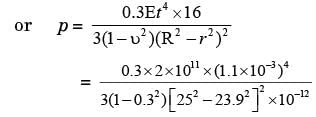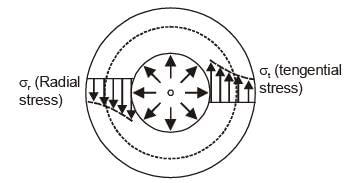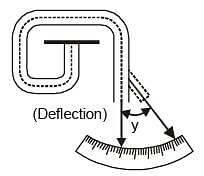GATE Exam > GATE Questions > The diaphragm element of a pressure gauge is...
Start Learning for Free
The diaphragm element of a pressure gauge is a circular foil of steel (Young’s modulus, E = 2 x 1011 N/m2, Poisson’s ratio, v = 0.3) which is firmly clamped around its circumference. The radius (R) and thickness (t) of the element are 25 mm and 1.1 mm respectively. On the application of uniform pressure (p), the deflection (y) at any radial position (r) measured from the center is given by the expression: (2002)

(a) Find the maximum design pressure if the allowable deflection of the element is limited to 0.3 times its thickness.
(b) Schematically show the variations of deflection, the radial and tangential stresses from the centerline to the edge of the diaphragm element.
Correct answer is '11.12'. Can you explain this answer?
| FREE This question is part of | Download PDF Attempt this Test |
Verified Answer
The diaphragm element of a pressure gauge is a circular foil of steel...
11. Given E = 2 * 1011 N/m2, o = 0.3, R = 25 mm, t = 1.1 mm,




View all questions of this test
∴ r = R - t = 25 - 1.1 = 23.9 mm
(a)

When y = 0.3 × t


= 11.12 MN/m2
(b)


Most Upvoted Answer
The diaphragm element of a pressure gauge is a circular foil of steel...
11. Given E = 2 * 1011 N/m2, o = 0.3, R = 25 mm, t = 1.1 mm,




∴ r = R - t = 25 - 1.1 = 23.9 mm
(a)

When y = 0.3 × t


= 11.12 MN/m2
(b)



|
Explore Courses for GATE exam
|

|
Similar GATE Doubts
The diaphragm element of a pressure gauge is a circular foil of steel (Young’s modulus, E = 2 x 1011 N/m2, Poisson’s ratio, v = 0.3) which is firmly clamped around its circumference. The radius (R) and thickness (t) of the element are 25 mm and 1.1 mm respectively. On the application of uniform pressure (p), the deflection (y) at any radial position (r) measured from the center is given by the expression: (2002)(a) Find the maximum design pressure if the allowable deflection of the element is limited to 0.3 times its thickness.(b) Schematically show the variations of deflection, the radial and tangential stresses from the centerline to the edge of the diaphragm element.Correct answer is '11.12'. Can you explain this answer?
Question Description
The diaphragm element of a pressure gauge is a circular foil of steel (Young’s modulus, E = 2 x 1011 N/m2, Poisson’s ratio, v = 0.3) which is firmly clamped around its circumference. The radius (R) and thickness (t) of the element are 25 mm and 1.1 mm respectively. On the application of uniform pressure (p), the deflection (y) at any radial position (r) measured from the center is given by the expression: (2002)(a) Find the maximum design pressure if the allowable deflection of the element is limited to 0.3 times its thickness.(b) Schematically show the variations of deflection, the radial and tangential stresses from the centerline to the edge of the diaphragm element.Correct answer is '11.12'. Can you explain this answer? for GATE 2024 is part of GATE preparation. The Question and answers have been prepared according to the GATE exam syllabus. Information about The diaphragm element of a pressure gauge is a circular foil of steel (Young’s modulus, E = 2 x 1011 N/m2, Poisson’s ratio, v = 0.3) which is firmly clamped around its circumference. The radius (R) and thickness (t) of the element are 25 mm and 1.1 mm respectively. On the application of uniform pressure (p), the deflection (y) at any radial position (r) measured from the center is given by the expression: (2002)(a) Find the maximum design pressure if the allowable deflection of the element is limited to 0.3 times its thickness.(b) Schematically show the variations of deflection, the radial and tangential stresses from the centerline to the edge of the diaphragm element.Correct answer is '11.12'. Can you explain this answer? covers all topics & solutions for GATE 2024 Exam. Find important definitions, questions, meanings, examples, exercises and tests below for The diaphragm element of a pressure gauge is a circular foil of steel (Young’s modulus, E = 2 x 1011 N/m2, Poisson’s ratio, v = 0.3) which is firmly clamped around its circumference. The radius (R) and thickness (t) of the element are 25 mm and 1.1 mm respectively. On the application of uniform pressure (p), the deflection (y) at any radial position (r) measured from the center is given by the expression: (2002)(a) Find the maximum design pressure if the allowable deflection of the element is limited to 0.3 times its thickness.(b) Schematically show the variations of deflection, the radial and tangential stresses from the centerline to the edge of the diaphragm element.Correct answer is '11.12'. Can you explain this answer?.
The diaphragm element of a pressure gauge is a circular foil of steel (Young’s modulus, E = 2 x 1011 N/m2, Poisson’s ratio, v = 0.3) which is firmly clamped around its circumference. The radius (R) and thickness (t) of the element are 25 mm and 1.1 mm respectively. On the application of uniform pressure (p), the deflection (y) at any radial position (r) measured from the center is given by the expression: (2002)(a) Find the maximum design pressure if the allowable deflection of the element is limited to 0.3 times its thickness.(b) Schematically show the variations of deflection, the radial and tangential stresses from the centerline to the edge of the diaphragm element.Correct answer is '11.12'. Can you explain this answer? for GATE 2024 is part of GATE preparation. The Question and answers have been prepared according to the GATE exam syllabus. Information about The diaphragm element of a pressure gauge is a circular foil of steel (Young’s modulus, E = 2 x 1011 N/m2, Poisson’s ratio, v = 0.3) which is firmly clamped around its circumference. The radius (R) and thickness (t) of the element are 25 mm and 1.1 mm respectively. On the application of uniform pressure (p), the deflection (y) at any radial position (r) measured from the center is given by the expression: (2002)(a) Find the maximum design pressure if the allowable deflection of the element is limited to 0.3 times its thickness.(b) Schematically show the variations of deflection, the radial and tangential stresses from the centerline to the edge of the diaphragm element.Correct answer is '11.12'. Can you explain this answer? covers all topics & solutions for GATE 2024 Exam. Find important definitions, questions, meanings, examples, exercises and tests below for The diaphragm element of a pressure gauge is a circular foil of steel (Young’s modulus, E = 2 x 1011 N/m2, Poisson’s ratio, v = 0.3) which is firmly clamped around its circumference. The radius (R) and thickness (t) of the element are 25 mm and 1.1 mm respectively. On the application of uniform pressure (p), the deflection (y) at any radial position (r) measured from the center is given by the expression: (2002)(a) Find the maximum design pressure if the allowable deflection of the element is limited to 0.3 times its thickness.(b) Schematically show the variations of deflection, the radial and tangential stresses from the centerline to the edge of the diaphragm element.Correct answer is '11.12'. Can you explain this answer?.
Solutions for The diaphragm element of a pressure gauge is a circular foil of steel (Young’s modulus, E = 2 x 1011 N/m2, Poisson’s ratio, v = 0.3) which is firmly clamped around its circumference. The radius (R) and thickness (t) of the element are 25 mm and 1.1 mm respectively. On the application of uniform pressure (p), the deflection (y) at any radial position (r) measured from the center is given by the expression: (2002)(a) Find the maximum design pressure if the allowable deflection of the element is limited to 0.3 times its thickness.(b) Schematically show the variations of deflection, the radial and tangential stresses from the centerline to the edge of the diaphragm element.Correct answer is '11.12'. Can you explain this answer? in English & in Hindi are available as part of our courses for GATE.
Download more important topics, notes, lectures and mock test series for GATE Exam by signing up for free.
Here you can find the meaning of The diaphragm element of a pressure gauge is a circular foil of steel (Young’s modulus, E = 2 x 1011 N/m2, Poisson’s ratio, v = 0.3) which is firmly clamped around its circumference. The radius (R) and thickness (t) of the element are 25 mm and 1.1 mm respectively. On the application of uniform pressure (p), the deflection (y) at any radial position (r) measured from the center is given by the expression: (2002)(a) Find the maximum design pressure if the allowable deflection of the element is limited to 0.3 times its thickness.(b) Schematically show the variations of deflection, the radial and tangential stresses from the centerline to the edge of the diaphragm element.Correct answer is '11.12'. Can you explain this answer? defined & explained in the simplest way possible. Besides giving the explanation of
The diaphragm element of a pressure gauge is a circular foil of steel (Young’s modulus, E = 2 x 1011 N/m2, Poisson’s ratio, v = 0.3) which is firmly clamped around its circumference. The radius (R) and thickness (t) of the element are 25 mm and 1.1 mm respectively. On the application of uniform pressure (p), the deflection (y) at any radial position (r) measured from the center is given by the expression: (2002)(a) Find the maximum design pressure if the allowable deflection of the element is limited to 0.3 times its thickness.(b) Schematically show the variations of deflection, the radial and tangential stresses from the centerline to the edge of the diaphragm element.Correct answer is '11.12'. Can you explain this answer?, a detailed solution for The diaphragm element of a pressure gauge is a circular foil of steel (Young’s modulus, E = 2 x 1011 N/m2, Poisson’s ratio, v = 0.3) which is firmly clamped around its circumference. The radius (R) and thickness (t) of the element are 25 mm and 1.1 mm respectively. On the application of uniform pressure (p), the deflection (y) at any radial position (r) measured from the center is given by the expression: (2002)(a) Find the maximum design pressure if the allowable deflection of the element is limited to 0.3 times its thickness.(b) Schematically show the variations of deflection, the radial and tangential stresses from the centerline to the edge of the diaphragm element.Correct answer is '11.12'. Can you explain this answer? has been provided alongside types of The diaphragm element of a pressure gauge is a circular foil of steel (Young’s modulus, E = 2 x 1011 N/m2, Poisson’s ratio, v = 0.3) which is firmly clamped around its circumference. The radius (R) and thickness (t) of the element are 25 mm and 1.1 mm respectively. On the application of uniform pressure (p), the deflection (y) at any radial position (r) measured from the center is given by the expression: (2002)(a) Find the maximum design pressure if the allowable deflection of the element is limited to 0.3 times its thickness.(b) Schematically show the variations of deflection, the radial and tangential stresses from the centerline to the edge of the diaphragm element.Correct answer is '11.12'. Can you explain this answer? theory, EduRev gives you an
ample number of questions to practice The diaphragm element of a pressure gauge is a circular foil of steel (Young’s modulus, E = 2 x 1011 N/m2, Poisson’s ratio, v = 0.3) which is firmly clamped around its circumference. The radius (R) and thickness (t) of the element are 25 mm and 1.1 mm respectively. On the application of uniform pressure (p), the deflection (y) at any radial position (r) measured from the center is given by the expression: (2002)(a) Find the maximum design pressure if the allowable deflection of the element is limited to 0.3 times its thickness.(b) Schematically show the variations of deflection, the radial and tangential stresses from the centerline to the edge of the diaphragm element.Correct answer is '11.12'. Can you explain this answer? tests, examples and also practice GATE tests.

|
Explore Courses for GATE exam
|

|
Suggested Free Tests
Signup for Free!
Signup to see your scores go up within 7 days! Learn & Practice with 1000+ FREE Notes, Videos & Tests.


















